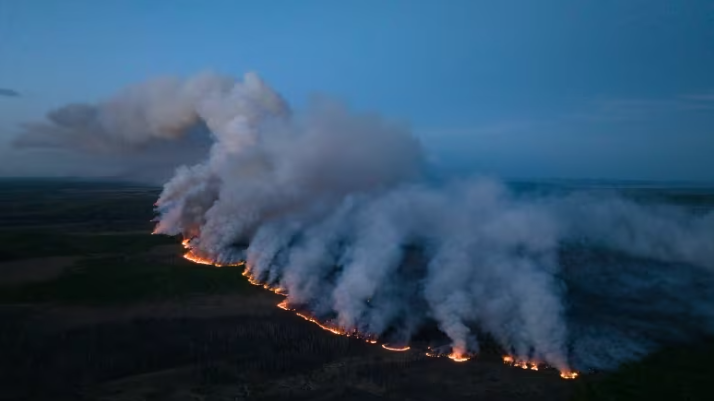Heat wave challenges firefighters in B.C. as new wildfires prompt evacuations

More than 100 homes on evacuation order due to Stoddart Creek fire in northeastern B.C.
Northeastern B.C. continues to see large wildfires burn out of control, as unusually hot weather challenges firefighters.
Dozens of people remained out of their homes Sunday in areas around Fort St. John, B.C., due to evacuation orders and alerts associated with the Red Creek fire, which has now been burning for more than a week.
A newly-discovered blaze called the Stoddart Creek fire, just north of Red Creek, has prompted a door-to-door evacuation operation due to the safety risks associated with that fire, while other properties are on an evacuation alert.
The Stoddart Creek wildfire was discovered around 3 p.m. PT Saturday, and is burning over an area of 12.31 square kilometres. The Peace River Regional District says 136 homes have been placed on evacuation order as of Sunday afternoon.
The wildfires come as a heat wave continues across the province, with little overnight reprieve for emergency responders from the B.C. Wildfire Service.
“It’s May and so it feels early, but we’re seeing July conditions out there,” said Hannah Swift, a fire information officer.
Daytime temperatures are forecast to be 10 C to 15 C above the seasonal average until at least Tuesday, according to Environment Canada.

The hot conditions are adding to extreme drought in the Peace region of northeastern B.C., where the biggest fires are burning. Additional firefighting resources are being dedicated to what is being called the North Peace Fire Complex, consisting of four large fires.
Swift says the high spring temperatures — which have already accelerated snowmelt in much of the province — have meant that the Peace region has had little time to recover from the drought, which started last fall.
“Coming out of winter and heading into spring, we had the snowmelt and we went directly back into summer [conditions],” she said. “We are seeing very high temperatures, very low relative humidities very early in the day. So, that burning window — where we see kind of that peak fire behaviour — is getting longer and longer.”
Swift says, however, that crews continue to make good progress on the Boundary Lake fire burning on the B.C.-Alberta border, after conducting planned ignitions to limit the fire’s growth. Three homes were destroyed by the fire last week.

As of Sunday afternoon, 56 fires are burning across B.C. and 15 of them are considered out of control.
An evacuation alert means residents should prepare to evacuate their homes, possibly with little to no notice. An evacuation order means a resident should leave immediately.
Smaller fire discovered in Metro Vancouver
The Peace River Regional District also issued evacuation orders for a “remote area” north of Fort St. John due to the Donnie Creek and Tommy Lake fires. The Donnie Creek wildfire covers an area of 263 square kilometres.
In a statement, the district says the area is “used primarily by the forestry and oil and gas industry,” with B.C.’s energy regulator saying that some fossil fuel operations have been halted already due to fire activity.

“Most of the fires that we’re seeing in this area are suspected [to be] human caused,” Swift said.
“We really do ask the public just to help us out in that regard, to ensure they’re doing the best they can when they’re recreating,” she continued. “So that we can focus on the fires that we already have and make progress on those ones, because the new ones will just divert our resources even further.”
While many of B.C.’s most concerning fires are burning well away from the coast, a much smaller fire was reported at around 9 p.m. in Farrer Cove, adjacent to Belcarra Regional Park in Metro Vancouver.
Jay Sharpe, from the Sasamat Volunteer Fire Department, said the fire was contained after firefighters worked overnight, adding it was likely caused by a power line malfunction and that the incident showed the need for extra vigilance in the heat.
A Category 2 and Category 3 fire ban — which include open fires that burn material in piles, as well as burning stubble or grass and fireworks — is in place across the Central Interior and northern B.C.
B.C.’s fires of note as of 12 p.m. on May 14
All of B.C.’s most visible fires on Sunday afternoon were in the northeast, near the Alberta border.
Related News
Trade war, slumping border traffic: What does that mean for the Gordie Howe bridge?
Amid U.S. President Donald Trump’s tariffs which have triggered a trade war with Canada, cross-border trips haveRead more
Trump administration threatens Harvard’s foreign enrolment, tax-exempt status
U.S. Homeland Security Secretary Kristi Noem speaks during an event on April 9, in Washington,Read more
